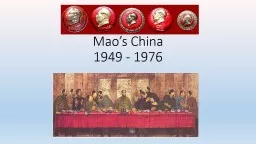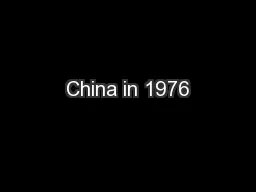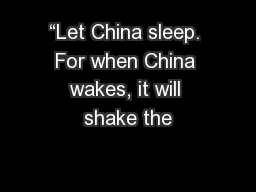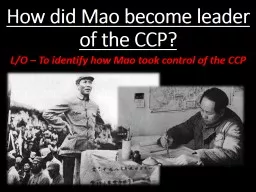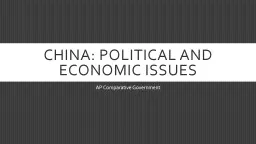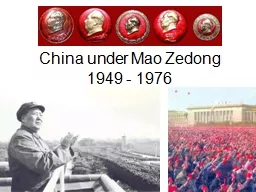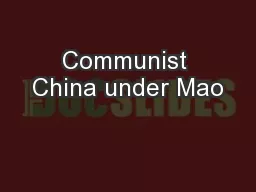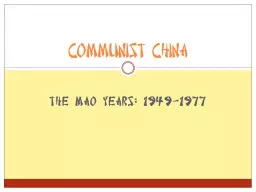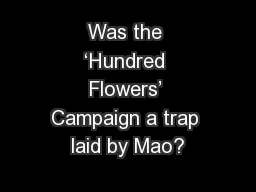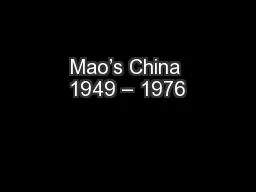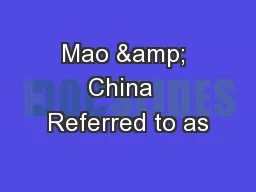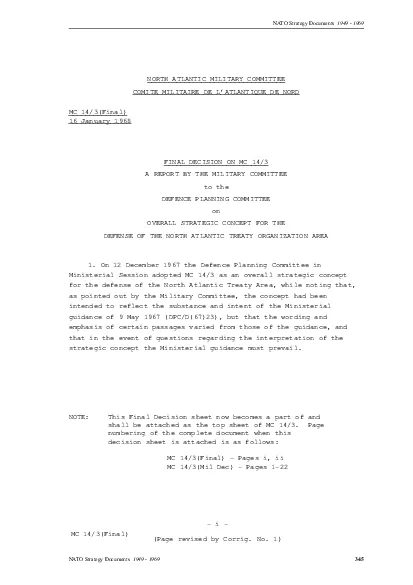PPT-Mao’s China 1949 - 1976
Author : alexa-scheidler | Published Date : 2018-10-21
Presentation Outline Theoretical Maoism Overview of the Civil War in China The Great Leap Forward The 100 Flowers Campaign The Cultural Revolution Maoist Propaganda
Presentation Embed Code
Download Presentation
Download Presentation The PPT/PDF document "Mao’s China 1949 - 1976" is the property of its rightful owner. Permission is granted to download and print the materials on this website for personal, non-commercial use only, and to display it on your personal computer provided you do not modify the materials and that you retain all copyright notices contained in the materials. By downloading content from our website, you accept the terms of this agreement.
Mao’s China 1949 - 1976: Transcript
Presentation Outline Theoretical Maoism Overview of the Civil War in China The Great Leap Forward The 100 Flowers Campaign The Cultural Revolution Maoist Propaganda Conclusions Reconciliation with the West. L/O – To identify the reasons why the CCP won the 2. nd. Civil War.. China in 1945. When war ended in . Aug 1945. , the CCP controlled most of the . countryside. & the KMT was stuck in . Sichuan province. Mao’s Legacy. Key Questions. What was Maoism?. Who were the major figures in the PRC under Mao and what were the major events during his rule?. Who were the contenders to be his successor upon his death in 1976?. Confucianism - The philosophy has shaped the Chinese political system since the 6th century B.C.E. . It emphasized the importance of order and harmony, and encouraged Chinese citizens to submit to the emperor's power, and reinforced the emperors' responsibility to fulfill his duties conscientiously. . L/O – To identify how Mao took control of the CCP. Tasks. Make a timeline of Mao’s rise to power from 1919-1937. Include a brief description of each event (50 words max).. What were the most important events in Mao’s rise to power? Why? (try to identify at least 3 events). Change. AP Comparative Government. Political and Economic Change. China and Russia are similar in that they have had long periods of peace followed by great upheaval. During the 20. th. . century, . 1949 - 1976. Outline. GMD-CCP Civil War (1946-1949). Recovery and Socialism (1949-1956). Rethinking the Soviet model (1956-1957). Great Leap Forward (1958-1961). Recovery & growing elite division (1962-5). L/O – To examine the . agricultural, industrial and . social reforms of the Communists between 1949-1957. What problems did Mao have in 1949?. Try to think about the legacy of the Second World War and Civil War on China. L/O – To examine the political, economic and social changes to China in the post-war reconstruction period. “Now I have power, what problems does China face?”. 中国人民从此站起来了. !. “We must have faith in the masses and we must have faith in the Party. These are two cardinal principles. If we doubt these principles, we shall accomplish nothing.”. Mao Zedong. “Protect the interests of the youth, women and children - provide assistance to young students who cannot afford to continue their studies, help the youth and women to organize in order to participate on an equal footing in all work useful to the war effort and to social progress, ensure freedom of marriage and equality as between men and women, and give young people and children a useful education....”. Communist China. The . Good Years: 1949-1958. China Packet III, Assignment 1. Assignment 1. New Expectations. Once the Nationalists were defeated, . Chairman Mao Zedong . and China’s Communists brought changes to every village. When dedicated Communist Party members arrived in a village to enact changes, he or she (usually) had the support of grateful peasants. . L/O – To evaluate why Mao launched the Hundred Flowers and Anti-Rightist Campaigns of 1956-57. Impact of the First Five Year Plan. By 1956 the . rapid industrialisation . of the First Five Year Plan was putting Chinese society under . Introductory Lesson . What does China mean to you? . What does this man mean to you? (if anything?) . Do you know any of these places? . B. C. D. A. E. F. Who was responsible for the most deaths…? . Chairman Mao. . Chinese communist revolutionary. guerrilla warfare strategist. author . political theorist. and leader of the Chinese Revolution. . He was the architect of the People's Republic of China (PRC) from its establishment in 1949, and held authoritarian control over the nation until his death in 1976. . MC 14/3FinalNORTHATLANTICMILITARYCOMMITTEECOMITEMILITAIREDELATLANTIQUEDENORDMC14/3Final16January1968FINALDECISIONONMC14/3A REPORT BY THE MILITARY COMMITTEEto theDEFENCE PLANNING COMMITTEEonOVERALL STR
Download Document
Here is the link to download the presentation.
"Mao’s China 1949 - 1976"The content belongs to its owner. You may download and print it for personal use, without modification, and keep all copyright notices. By downloading, you agree to these terms.
Related Documents

